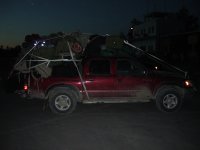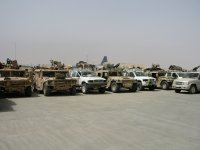I've been trying to describe what an overland rig is, not trying to say it's better or worse in any way. The original question of this entire discussion was "Roof Rack + Snorkel + Overland?
Completely understood, not fighting you on this :thumb: And I think that all I'm trying to do as well as the OP, Wayolife, is point out that the "overland" guys might be getting it wrong in certain aspects of building a vehicle for long distance adventuring.....which both Wayolife, I and many others have done successfully in our rigs. Easiest example to state is the JK Experience, I drove just under 1000 miles to the starting point, 900 plus miles during the event, and returned home for another almost 1000 miles logged all in one week. Some participants drove much further from N.C. to Colorado, drove the event, then returned to N.C. In fact, ironically there was not one "overland" style built rig in the line up of 22 vehicles. Hell there was even a full size GMC truck support vehicle that ran the Entire event.
......To be quite honest, even going for the fat rock-crawling tires of WayofLife's three rigs is overkill since replacements even for that size tire may be impossible in some places that overland rigs may travel outside the United States.
As Wayoflife stated, I too have yet to need my spare 40" as a replacement in 28,000 miles. However, while doing "overland" travel in foreign lands, I can't count the number of skinny little Land Rover 100-110 series, Toyota FJ75 series tires, some are still split rim tube tires. Bottom line is, I've yet to stumble into a village and not be able to get a tire hot patched from the inside.
One more aspect of skinny tires and there failure, load carrying. The weight of most "overlanding" rigs is just incredible. So why would you upgrade your tent, you cooking capabilities, showering potential, fuel capacity, potable water carrying capacity, etc...... yet do the minimum of tire and suspension upgrades? Sounds counterproductive :thinking:
... all of a sudden the JK stands to take over that role in international overland exploration
.
I think you are definitely on to something here :thumb: I have a friend that is one of the founders and Editors of Overland Journal magazine, he would definitely agree with you also, but more so here in the US. The Land Rover solid axle platforms have just recently stopped being produced and the Toyota solid axle trucks are still in production, so it's to early for the JK to dominate worldwide and that may not happen if it should ever go independent suspension.
.......As I said, most modified Jeeps in the US are probably far more rig than such groups would want because they would see all those modifications as wasted money.
As Wayoflife stated, this always seems to be the case until someone is educated on why the modification is purchased and then they actually drive the vehicle with the questionable mod. My rig's build is a culmination of the best attributes of almost every aspect of all facets of the types of offroading out there. There is bleed over technology from even Formula 1 on our rigs (e.g. EVO lever suspension)
?.....Sure, your Land Rover may take the bypasses, but overland exploration is looking for the easiest available route, not the most difficult. if a horse and cart can go over the trail, the Land Rover (Defender?) can take that same trail and the base Unlimited X, Sport and even Sahara can do just as well if not better.
....that's not the intent or purpose of an overland rig. Get through however you can, the easiest trail you can find, and you've succeeded. Less is more in that case.
Absolutely, you are correct. Route selection is the first thing in exploration, the gear you bring along is tailored for the routes/terrain/environment you must traverse. Having a vehicle that is built to handle the occasional "extreme" trail can be the reason between taking a 20 foot bypass or a 60 mile detour.
Besides, you guys tried that crusading thing back in 1812. Did not have the intended result...
You are correct, cant argue with you there! Our country is great at war fighting, but we absolutely suck at nation building :doh:
Closing Comment: this is an awesome thread! As much as I love the JK Forum, I think this discussion would have devolved into some Internet shouting match. Thanks for keeping it adult like fellas :rock:


